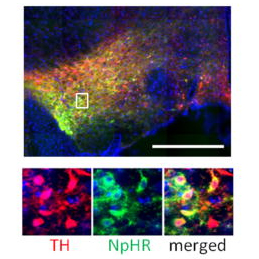Hot Off the Press! – December 2015

Chang, Chun Yun; Esber, Guillem R; Marrero-Garcia, Yasmin; Yau, Hau-Jie; Bonci, Antonello; Schoenbaum, Geoffrey
Brief optogenetic inhibition of dopamine neurons mimics endogenous negative reward prediction errors. Journal Article
In: Nat Neurosci, vol. 19, no. 1, pp. 111–116, 2016, ISSN: 1546-1726 (Electronic); 1097-6256 (Linking).
@article{Chang2016,
title = {Brief optogenetic inhibition of dopamine neurons mimics endogenous negative reward prediction errors.},
author = {Chun Yun Chang and Guillem R Esber and Yasmin Marrero-Garcia and Hau-Jie Yau and Antonello Bonci and Geoffrey Schoenbaum},
url = {http://www.ncbi.nlm.nih.gov/pubmed/26642092},
doi = {10.1038/nn.4191},
issn = {1546-1726 (Electronic); 1097-6256 (Linking)},
year = {2016},
date = {2016-01-01},
journal = {Nat Neurosci},
volume = {19},
number = {1},
pages = {111--116},
address = {National Institute on Drug Abuse Intramural Research Program, Cellular Neurobiology Research Branch, Behavioral Neurophysiology Research Section, Baltimore, Maryland, USA.},
abstract = {Correlative studies have strongly linked phasic changes in dopamine activity with reward prediction error signaling. But causal evidence that these brief changes in firing actually serve as error signals to drive associative learning is more tenuous. Although there is direct evidence that brief increases can substitute for positive prediction errors, there is no comparable evidence that similarly brief pauses can substitute for negative prediction errors. In the absence of such evidence, the effect of increases in firing could reflect novelty or salience, variables also correlated with dopamine activity. Here we provide evidence in support of the proposed linkage, showing in a modified Pavlovian over-expectation task that brief pauses in the firing of dopamine neurons in rat ventral tegmental area at the time of reward are sufficient to mimic the effects of endogenous negative prediction errors. These results support the proposal that brief changes in the firing of dopamine neurons serve as full-fledged bidirectional prediction error signals.},
keywords = {},
pubstate = {published},
tppubtype = {article}
}
Correlative studies have strongly linked phasic changes in dopamine activity with reward prediction error signaling. But causal evidence that these brief changes in firing actually serve as error signals to drive associative learning is more tenuous. Although there is direct evidence that brief increases can substitute for positive prediction errors, there is no comparable evidence that similarly brief pauses can substitute for negative prediction errors. In the absence of such evidence, the effect of increases in firing could reflect novelty or salience, variables also correlated with dopamine activity. Here we provide evidence in support of the proposed linkage, showing in a modified Pavlovian over-expectation task that brief pauses in the firing of dopamine neurons in rat ventral tegmental area at the time of reward are sufficient to mimic the effects of endogenous negative prediction errors. These results support the proposal that brief changes in the firing of dopamine neurons serve as full-fledged bidirectional prediction error signals.
